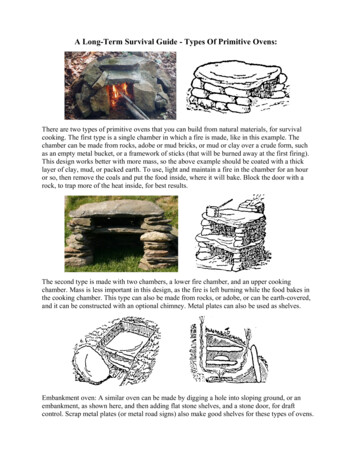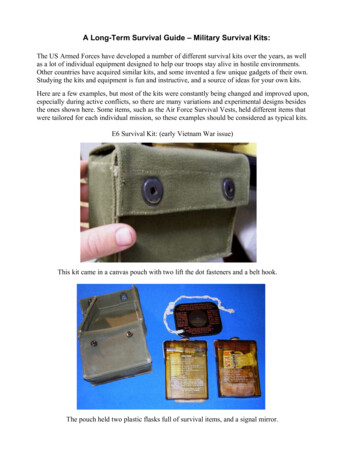
Transcription
A Long-Term Survival Guide - Types Of Primitive Ovens:There are two types of primitive ovens that you can build from natural materials, for survivalcooking. The first type is a single chamber in which a fire is made, like in this example. Thechamber can be made from rocks, adobe or mud bricks, or mud or clay over a crude form, suchas an empty metal bucket, or a framework of sticks (that will be burned away at the first firing).This design works better with more mass, so the above example should be coated with a thicklayer of clay, mud, or packed earth. To use, light and maintain a fire in the chamber for an houror so, then remove the coals and put the food inside, where it will bake. Block the door with arock, to trap more of the heat inside, for best results.The second type is made with two chambers, a lower fire chamber, and an upper cookingchamber. Mass is less important in this design, as the fire is left burning while the food bakes inthe cooking chamber. This type can also be made from rocks, or adobe, or can be earth-covered,and it can be constructed with an optional chimney. Metal plates can also be used as shelves.Embankment oven: A similar oven can be made by digging a hole into sloping ground, or anembankment, as shown here, and then adding flat stone shelves, and a stone door, for draftcontrol. Scrap metal plates (or metal road signs) also make good shelves for these types of ovens.
Ammo Can Oven: Another style of two-chamber oven is the ammo can oven, which can be madefrom any large metal box with a lid. The can will be the upper chamber, or oven section. Stones(mortared with mud) are used to construct the lower chamber, or fire section, and then the can isplaced on top, and covered with a thick layer of mud or adobe. An optional chimney hole can beused to draw the hot air around the back side of the box, for better heating. The ammo can lid isused as the door to the oven section, and as a shelf, if it is hinged and arranged as shown here.Simple ovens can be made by first constructing a framework of sticks, and then adding a thicklayer of mud, clay, or adobe (which is just mud mixed with chopped grass or straw). The stickswill burn away when the first fire is built inside, leaving the fire-hardened shell behind. A log ora bundle of sticks can be used to form a chimney, and flat stones (or slabs of green wood) can beused to block the doorway, both to regulate the fire, and to trap the heat inside.
These simple mud-brick, or adobe dome ovens can be built on raised platforms, if desired.Here is one way to make a primitive mud brick oven: Using pliable twigs or bundles of grasses,make a structure that resembles the shape of the pictures above. Make an adobe mix, from mudand grass. Plaster the mix all over the outside of the frame to a depth of two inches, or more. Youcan check the depth by pushing a stick through the wall. Smooth off the outside of the wall witha damp trowel, or similar improvised tool. Allow the structure to dry a little. Place wood andkindling inside the oven and light. Keep the fire going by adding more wood - but slowly, as youdon't want to ruin the oven with too much heat. You just want to harden the clay with a hot, butnot fierce heat. When the oven is fully dried, and the sticks have been burned out, you can usethe oven for cooking. Another design uses mud and grass mixed into bricks, which are made insimple molds like the example shown below, allowed to dry some, then stacked into a dome, likean igloo. Ovens of this type can also be made from mud on a frame of rebar, wire mesh, a metalbarrel, ammo cans, etc.
Rake the coals from a single-chamber oven, put the food inside, and then seal doorway with arock, or a wooden door, to keep most of the heat inside.For long-term use, protect your mud-brick oven (and your firewood) from rain by covering itwith a shed roof.Ovens are very useful, because you can bake your food, and cook multiple items at once.
Mud or clay stoves are similar to the clay dome ovens, only smaller. They are constructed with ahole on top, for setting a pot or pan on. These stoves concentrate the heat from very small firesonto the bottom of the cooking pots, making them very fuel-efficient.This is a diagram of one style of clay stove, showing front, side, and top views.Wood-burning ovens can be crudely made, or as ornate as you might want, but they are notportable. For on the go baking, one solution is the dutch oven, which comes in a variety of sizes,and can be found in either iron, or aluminum.Dutch ovens are heavy (but useful) survival tools, good for tenderizing tough game animals.They are good for making soups and stews, but they can also bake bread, or fry doughnuts.
A Long-Term Survival Guide - Types Of Primitive Ovens: There are two types of primitive ovens that you can build from natural materials, for survival cooking. The first type is a single chamber in which a fire is made, like in this example. The chamber can be made from rocks, adobe or mud bricks, or mud or clay over a crude form, such









![[ST] Survival Analysis - Stata](/img/33/st.jpg)

